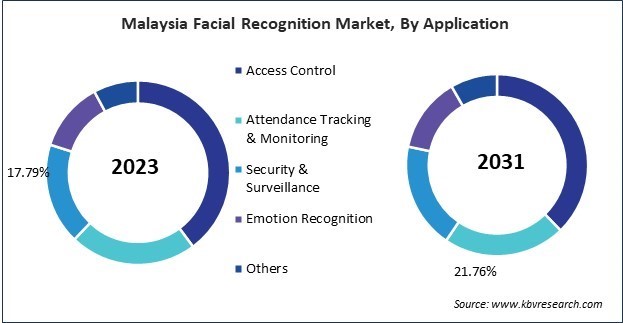The Asia Pacific Facial Recognition Market would witness market growth of 15.3% CAGR during the forecast period (2024-2031).
The China market dominated the Asia Pacific Facial Recognition Market by Country in 2023, and would continue to be a dominant market till 2031; thereby, achieving a market value of $1,283.5 million by 2031. The Japan market is registering a CAGR of 14.5% during (2024 - 2031). Additionally, The India market would showcase a CAGR of 16% during (2024 - 2031).

Integrating this technology with edge computing platforms and IoT devices enables real-time processing and analysis of facial biometrics at the network's edge, reducing latency, enhancing privacy, and enabling new applications in smart cities, and connected retail environments. Integrating identity verification with edge computing enables the development of innovative applications in smart cities, such as real-time pedestrian and vehicle monitoring, traffic analysis, and crowd management.
By deploying edge devices equipped with identity verification capabilities at key locations throughout the city, authorities can gather valuable insights into traffic patterns, urban mobility, and public behavior, enabling data-driven decision-making and proactive interventions to improve city services and enhance public safety. This has prompted organizations to prioritize privacy-preserving technologies, transparent practices, and responsible deployment strategies to mitigate risks and build user trust.
As per the data from the Government of China, the Chinese smart home sector experienced a substantial development rate of nearly 20 percent annually from 2016 to 2021, expanding from 260 billion yuan ($36.25 billion) to 580 billion yuan. By 2025, the smart home sector in Zhejiang province is projected to reach a value of 500 billion yuan. Additionally, the Indian government has launched various initiatives and programs to modernize the country's security infrastructure and combat security threats effectively. The Smart Cities Mission, Safe City Project, and Integrated Check Post (ICP) project emphasize deploying advanced facial recognition technologies to enhance surveillance, law enforcement, and border security capabilities. Thus, the rising smart home and security sectors in Asia Pacific will drive the expansion of the regional market.
Free Valuable Insights: The Global Facial Recognition Market is Predict to reach USD 16.8 billion by 2031, at a CAGR of 14.5%
Based on Organization Size, the market is segmented into Large Enterprises, and Small & Medium Enterprises. Based on Deployment Mode, the market is segmented into On-premise, and Cloud. Based on Offering, the market is segmented into Software, Hardware, and Services. Based on Technology, the market is segmented into 3D, 2D, and Facial Analytics. Based on Application, the market is segmented into Access Control, Attendance Tracking & Monitoring, Security & Surveillance, Emotion Recognition, and Others. Based on Vertical, the market is segmented into Government, Media & Entertainment, Education, Healthcare & Lifesciences, Automobile & Transportation, Manufacturing, Retail & eCommerce, IT & Telecom, and Others. Based on countries, the market is segmented into China, Japan, India, South Korea, Singapore, Malaysia, and Rest of Asia Pacific.
By Organization Size
By Deployment Mode
By Offering
By Technology
By Application
By Vertical
By Country
Our team of dedicated experts can provide you with attractive expansion opportunities for your business.

